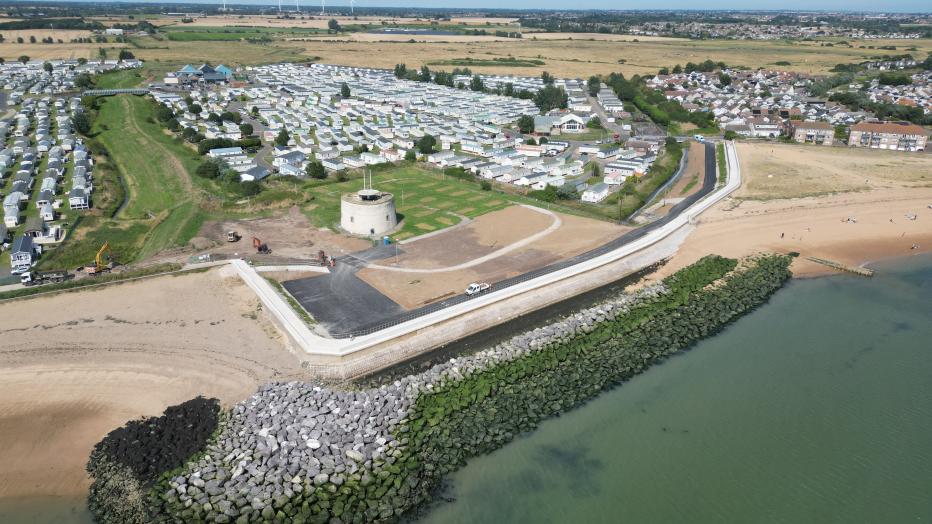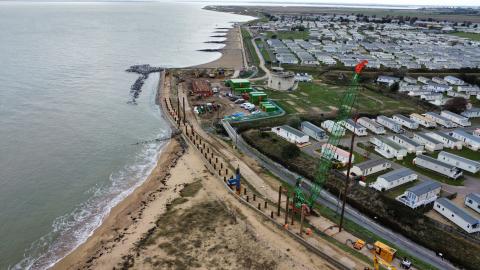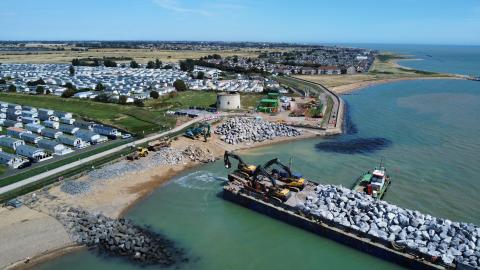Cockett Wick Seawall Improvements
Safeguarding over 3,000 homes and businesses with a sustainable flood defense scheme in Essex, UK

Completed scheme
Jacobs worked with the Environment Agency and partners to sustainably build a new seawall and rock revetment in a £12 million ($15.6 million) flood defense scheme to protect over 3,000 properties and businesses along a stretch of the Essex coastline.
The previous flood defenses at Jaywick in Essex were low and in poor condition — severely underequipped to face a future of climate-driven flood risk and ocean level rise as a seaside community. The flood threat and damage potential were made much greater due to the land behind the defenses lying at a much lower level. To help safeguard over 3,000 homes and businesses in the impact area, the Environment Agency appointed Jacobs to develop innovative options for seawall improvements as the design partner. The crux of the challenge: the solution needed to be sustainable, cost-effective and delivered to the highest standards. A second part of the challenge focused on resilience: could we design a seawall that’s adaptable and could be raised in the future?
“Ensuring sustainability discussions were undertaken early in the design program allowed for the design to develop with sustainability and carbon decisions at the forefront. From collaborative approaches to consideration of materials, transport and circular economy best practice, projects such as the these play a key part in decarbonizing our footprint while enhancing climate resilience and improving people’s lives.”
The challenge
The biggest threat for the seaside community of Jaywick and its inadequate seawall defenses was the risk of major flooding. Failure of the deteriorating seawall would result in high-velocity flooding, posing a deadly risk to the people in over 3,000 homes in the community and irreparable damage to the property and livelihood of over 80 businesses. Warnings of this rising danger were evident in evacuations of Jaywick during tidal storm surge events in 2013 and 2020. These evacuations left a deep, lasting impact on the mental and physical wellbeing of Jaywick’s residents.
A new, more resilient seawall was crucial to reduce the danger of high-velocity flooding. It would help protect lives and properties, and increase the confidence for future investment in the area.
-

Installation of the 24m long steel tube piles
-

Barge delivery of the Norwegian granite rocks
The solution
The project's success was built on thorough research and the application of sustainability as a filter in all the decision-making. One of the key decisions identified early in the planning stages was that the project required a new seawall to be built, independent of the existing one. That required a shortlist of technical solutions to be developed, and the technical, environmental and economic impacts of each option was analyzed. As the design partner on the project, Jacobs prepared the outline business case to secure funding from the U.K. government for the detailed design stage, which was approved in 2022.
At the detailed design stage, Jacobs worked closely with the contractor, BAM Nuttall, and the Environment Agency to develop a sustainable, adaptable design. In an early Sustainability Workshop, the team identified several opportunities for meeting the project’s ambitious carbon-saving goals. Instead of using new steel sheet piles, over 150 recycled steel tube piles were incorporated into the design, resulting in an estimated 1000tCO2e saved. As part of our focus on sustainability, we carefully adapted the rock revetment and seawall design to ensure the right seawall levels could be achieved while minimizing waste and energy.
As part of our early upfront work, we prepared an Environmental Impact Assessment and obtained all the planning permissions and the marine license needed. This early preparation and the close collaboration with the Marine Management Organisation ensured there were no delays to the program start. Within the next stage, we prepared a second full business case and secured funding from the U.K. government for the construction stage in 2023.
Before the building of the seawall started, Jacobs undertook a program of reptile relocation, moving over 200 reptiles to a specially constructed Hibernaculum. In addition, the team secured a water vole license to start mitigation works to carefully protect water voles in a channel neighboring the works.
Once construction started, our team continued to support the scheme through all the building work, providing design support and Site Supervisor and Environmental Clerk of Works (ECC) services.
The project is now complete and the new seawall and footpath have been opened to the public since July 2024.
-
152
Recycled 24m long steel tubular piles, saving ~1000tCO2e
-
330
Meters of new reinforced concrete footpath and seawall
-
14000
Tonnes of granite rocks imported from Norway, saving 700 lorry movements on the road and ~48tCO2e
-
100
Years of design life considering sea level rise, with provisions for raising the wall in 50 years’ time incorporated into the design
-
3000 +
Residential properties better protected from flooding
-
1200
Tonnes of surplus rock redistributed to support local erosion-protection projects
“The completion of the works marks a significant step in providing longer-term flood risk protection to the community of Jaywick and the foundation to support investment growth and regeneration for the area. The team’s collaborative approach and shared commitment to drive sustainability and seek new and innovative approaches have enabled the project to be a real success; this included exceeding its carbon efficiency targets.”
Key team members
-

Louise Oldfield-Trim, Project Manager
Louise led the project through the Outline Business Case and Full Business Case (detailed design) stages. She was also Project Manager for the Construction Support Stage.
-

Jack Eade, Assistant Project Manager
Jack assisted in the management and coordination of the project from full business case through to construction completion. He also worked on and managed the coastal design elements, including rock armor, wave overtopping and wave loading on the new wall. During the construction phase, he coordinated design responses to technical queries from the site team.
-

Matt House, Maritime Engineer and ECC Supervisor
Matt was involved in the structural design of the new wall as a junior engineer. He was then based on site full time during construction and worked closely with the client and contractor to help deliver the project smoothly and to a high standard.
-

Andy Schofield, Coastal Engineering Lead
Andy coordinated and led the design of the rock works seaward of the new seawall and provided general engineering advice on the overall scheme.
-

Rachel Wilson, Environmental Lead
Rachel coordinated the environmental deliverables and worked with the project management and client team to provide the necessary planning application supporting documents.
-

Matt Magson, Lead Ecologist
Matt was involved before construction with baseline protected species surveys and reporting for reptiles and water voles. He then delivered licensable water vole displacement on the nearby drain and worked with a wider ecology team that carried out reptile translocations.
-

Nick Gregory, ECC Supervisor
Nick was the named ECC supervisor in the contract. He attended the site regularly to monitor works, help resolve technical questions and review risk documents submitted by the contractor.
Award highlights
- Winner of ICE East of England Nature and People Positive Award
- Finalist for Environmental Project of the Year at the British Construction Industry Awards 2024














































